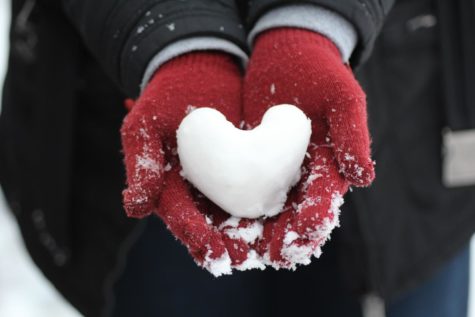Marginalized Winter Celebrations in Holiday Television
With another holiday season upon us, we see producers premiering a myriad of holiday-themed movies and television show episodes, but one has to wonder, where are the rest of the winter holidays?
“If you ask me, the miracle isn’t how each snowflake is perfectly formed. The real winter miracle is what can happen afterward. It’s called a snow day. It’s a day kids live for,” writes screenwriter Hal Brandston, played by the actor Mark Webber, on ‘Snow Day.’
We begin this story with a family sitting together by the fireplace. Unopened boxes of ornaments rest underneath the Christmas tree and the dinner table is set for the evening’s traditional meal. The only sound in the room is the crackling of the fire until there’s a knock at the door…
Wait, pause the movie for a second. This may seem quite familiar to you. As of late, Christmas movies, particularly Hallmark Christmas movies, have been said to be predictable and repetitive. For example, ‘Christmas Next Door,’ ‘A Godwink Christmas Meant for Love,’ ‘A Christmas Detour’ and many others all include a man and a woman tackling obstacles put in the way of one’s success and their relationship, but luckily, the pair manages to prevail and get together just in time for Christmas! This myriad of Christmas-related movies sparks the question: where are the movies about other holidays?
Although there’s some more acknowledgment towards other winter celebrations, many participants have agreed that these bits of representation in media are simply insufficient.
Underrepresentation is an ongoing issue that pops up most often in television media. There are a plethora of examples of television shows that marginalize or completely exclude groups of people around the world based on religion, race/ethnicity, sexuality, gender identity, and more. Glee, for example, includes characters of color who are always in the background and often fall into stereotypes. However, the holiday season is upon us, so let’s get into the holiday spirit and dedicate some time to highlighting the less recognized winter celebrations from around the world.
Before we delve into the beauty of different and unsung winter celebrations, we must recognize that underrepresentation digs deeper than simply leaving out a community or overlooking aspects of their identity in the media. By erasing entire groups of people from the media by overlooking celebrations important to their cultures, we erase an abundance of potential for content that could have fueled more acceptance towards other groups of people.
By only showing one celebration from one group of people on every screen, children will likely grow up without any figure in the entertainment world to look up to in regards to characters. Actors who celebrate different holidays but are cast into a film centralized around one may also feel marginalized in their own work.
All this results in the creation of a gap formed by media that makes content to cater to a single party, despite the fact that the United States is a ‘melting pot,’ given its diverse population.

You might have seen mentions of Hanukkah and Kwanzaa every year, particularly in episodes of children’s shows rather than in popular films. Although these two holidays are also given recognition, even those holidays are pushed aside. Many people outside of the Jewish community don’t know that Hanukkah is actually a rather minor holiday religious wise, but due to its close proximity to Christmas, the media turned it into a seemingly major holiday for the public and has gained a lot of cultural significance.
Hallmark has attempted at creating a “Hanukkah movie” this year, titled “Holiday Date,” which is about the protagonist’s urge to impress her family with a significant other that she doesn’t have, so she brings in a Jewish boy to act the part. However, the family gets suspicious when he doesn’t seem to know how to celebrate Christmas.
Although Hallmark argues that this movie is be a Hanukkah movie, the entire film is centered around Christmas and the idea that Jewish people don’t know how Christmas works, which treats Hanukkah like a strange third party.
“Holiday Date” claims to be a Hanukkah movie, but it simply provides the public with the idea that even when claiming to represent a Jewish holiday, Christmas will somehow manage to be at the center. This is unproductive and completely contradicts what Hallmark allegedly sought out to do.
If filmmakers only took the time to hire crew members that identify with groups that celebrate these holidays, there would be staff who could fact-check the content to ensure that the piece is accurate and respectful.
When asked for an opinion on the ratio of Christmas movies compared to media on other winter holidays, Jade Mendoza ’24 said, “ I feel like there are too many Christmas movies in the media today and just a lot of Christmas influence in the media. I feel like in children’s shows specifically, there’s more representation than back then, but the amount of Christmas media is still kind of overwhelming and more ingrained in American society.”
There’s so much out there to explore and turn into television content.
There’s Las Posadas, a Mexican celebration marking Mary and Joseph’s journey to Bethlehem through a procession led by a child dressed as an angel.
There’s Kwanzaa, a seven-day African-American holiday celebrating African American heritage, each day focusing on an important principle: unity (umoja), self-determination (kujichagulia), collective responsibility (ujima), cooperative economics (ujamaa), purpose (nia), creativity (kuumba), and faith (imani). Similar to Eid, this celebration includes a feast, Karamu, on the sixth day.
Although studios like Disney have animated shorts like Las Posadas, featured in Los Tres Caballeros, such animated shorts haven’t received any sort of advertising, it is simply a small part of a larger whole. Kwanzaa has received a bit more recognition. In the United States, media for children often features episodes of the characters either celebrating or learning about the holiday, such as Sesame Street’s Kwanzaa segment from 2008. Although these are examples of representation in the media, they pale in comparison to the Christmas movies and episodes produced every year.

Christian holidays outshine these holidays every single year, and when asked whether or not this is surprising, Haley Plummer ’24 said, “Not really, I think American media tends to ignore anything that doesn’t align with the traditional, Christian values that this country was built on.”
Mendoza continued, “I wish filmmakers made more movies about other holidays. Not only would this serve as more representation, but this could educate other people who don’t know anything about these holidays, which could, in turn, get rid of negative assumptions and stereotypes.”
Saara Ahmed ’25 agreed and noted that filmmakers and producers should start “talking with people from the cultures/religions that celebrate the holidays and asking them a bit about what they do during the holiday.”
More representation in the media would not only provide places for people of different cultures to view themselves on the big screen, but will also allow them to learn about celebrations outside of their circle. This, in turn, starts to eliminate unhealthy biases and stereotypes against other groups of people.
Though expected, it doesn’t make the overshadowing of other holidays acceptable. It’s time for more inclusive holiday movies. It’s time for filmmakers to come up with more original ideas for Christmas movies like they did for the first Home Alone movie and for The Nightmare Before Christmas, it’s time to include more diverse casts, and above all, it’s time to highlight and respect other lively and symbolic festivities from around the world.
More representation in the media would not only provide places for people of different cultures to view themselves on the big screen, but will also allow them to learn about celebrations outside of their circle. This, in turn, starts to eliminate unhealthy biases and stereotypes against other groups of people.
Ruby Moran is a Copy Chief for ‘The Science Survey.’ She believes that journalistic writing is essential for educating the public on crucial issues...











